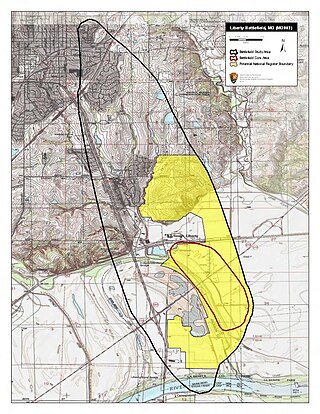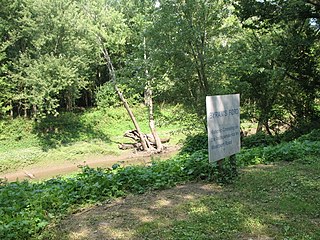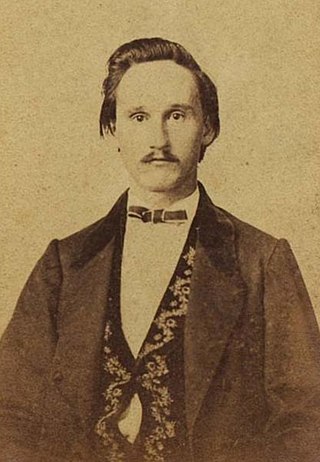
The Battle of Wilson's Creek, also known as the Battle of Oak Hills, was the first major battle of the Trans-Mississippi Theater of the American Civil War. It was fought on August 10, 1861, near Springfield, Missouri.

The Battle of Carthage, also known as the Engagement near Carthage, took place at the beginning of the American Civil War on July 5, 1861, near Carthage, Missouri. The experienced Colonel Franz Sigel commanded 1,100 Federal soldiers intent on keeping Missouri within the Union. The Missouri State Guard was commanded by Governor Claiborne F. Jackson himself and numbered over 4,000 soldiers led by a hero of Mexico, Sterling Price, along with 2,000 unarmed troops who did not participate in the battle.
The Battle of Dry Wood Creek, also known as the Battle of the Mules, was fought on September 2, 1861, in Vernon County, Missouri, during the American Civil War. After his victory at the Battle of Wilson's Creek on August 10, Sterling Price and the Missouri State Guard moved further north into Missouri. A force of Union troops under James H. Lane moved from Fort Scott, Kansas to attempt an interception of Price's army, and set an ambush along Dry Wood Creek. Price's Missouri State Guard troops outnumbered Lane's Kansas troops, and after a two hour skirmish forced Lane to retreat to Fort Scott. In their retreat, Lane's troops abandoned their supplies and mules to the Missourians. Price followed up his victory by continuing his northward march, culminating in another victory at the siege of Lexington, September 13 to 20, before returning south shortly afterwards.
The Battle of Glasgow was fought on October 15, 1864, in and near Glasgow, Missouri as part of Price's Missouri Expedition during the American Civil War. The battle resulted in the capture of needed weapons and improved Confederate morale, which had been dented after a defeat in the Battle of Pilot Knob.

The action at Blue Mills Landing, also known as the Battle of Liberty, was a battle of the American Civil War that took place on September 17, 1861, in Clay County, Missouri. Union forces unsuccessfully attempted to prevent pro-Southern Missouri State Guards from northwestern Missouri from crossing the Missouri River near the confluence with the Blue River to reinforce Sterling Price at Lexington.

The Battle of Byram's Ford was fought on October 22 and 23, 1864, in Missouri during Price's Raid, a campaign of the American Civil War. With the Confederate States of America collapsing, Major General Sterling Price of the Confederate States Army conducted an invasion of the state of Missouri in late 1864. Union forces led Price to abandon goals of capturing the cities of St. Louis and Jefferson City, and he turned west with his army towards Kansas City.

The First Battle of Boonville was a minor skirmish of the American Civil War, occurring on June 17, 1861, near Boonville in Cooper County, Missouri. Although casualties were extremely light, the battle's strategic impact was far greater than one might assume from its limited nature. The Union victory established what would become an unbroken Federal control of the Missouri River, and helped to thwart efforts to bring Missouri into the Confederacy.

The First Battle of Springfield was a battle of the American Civil War that took place on October 25, 1861, near Springfield, Missouri. Following the Battle of Wilson's Creek, the Missouri State Guard, a pro-Confederate militia organization, drove north and defeated a Federal (Union) force in the Siege of Lexington. Following the fighting at Lexington, Federal Major General John C. Frémont began a campaign that drove into southern Missouri. The main body of the Missouri State Guard fell back to Neosho, but a body of roughly 1,000 new recruits commanded by Colonel Julian Frazier was at Springfield. On October 24, Frémont sent a force raised as his bodyguard commanded by Major Charles Zagonyi on a scouting mission towards Springfield. After joining a cavalry force known as the Prairie Scouts at Bolivar, Zagonyi moved on towards Springfield on October 25.

The Missouri State Guard (MSG) was a military force established by the Missouri General Assembly on May 11, 1861. While not a formation of the Confederate States Army, the Missouri State Guard fought alongside Confederate troops and, at various times, served under Confederate officers.

During the American Civil War, Missouri was a hotly contested border state populated by both Union and Confederate sympathizers. It sent armies, generals, and supplies to both sides, maintained dual governments, and endured a bloody neighbor-against-neighbor intrastate war within the larger national war.

James Adelbert Mulligan was colonel of the 23rd Illinois Volunteer Infantry Regiment in the Union Army during the American Civil War. On February 20, 1865, the United States Senate confirmed the posthumous appointment of Mulligan to the rank of brevet brigadier general of U.S. Volunteers to rank from July 23, 1864, the day before he was mortally wounded at the Second Battle of Kernstown, near Winchester, Virginia. He commanded the Federal forces at the First Battle of Lexington, and later distinguished himself in other engagements in the Eastern theater prior to his death in battle.

James S. Rains was a senior officer of the Missouri State Guard (MSG) who fought in the Trans-Mississippi Theater of the American Civil War. Born in Tennessee, Rains moved to Missouri by 1840, and was a farmer, politician, judge, and militia officer. He also served as an Indian agent from 1845 to 1849, and participated in the California Gold Rush. He was appointed to command of the 8th Division of the MSG in May 1861, and may have commanded all MSG forces at the Battle of Carthage later that year. In August, his men were routed at the Battle of Dug Springs, an incident which became known as "Rains's Scare".
The Skirmish at Blackwater Creek, also known as the Skirmish at Milford, was an American Civil War skirmish that took place in central Missouri on December 19, 1861 near present-day Valley City. It was a victory for the North.

The 10th Arkansas Infantry (1861–1865) was a Confederate Army infantry regiment during the American Civil War from the state of Arkansas. The unit is also known as A. R. Witt's Infantry, C. M. Cargile's Infantry, E. L. Vaughan's Infantry, Thomas D. Merrick's Infantry, S. S. Ford's Infantry, Obed Patty's Infantry, George A. Merrick's Infantry, Zebulon Venable's Infantry and Robert C. Bertrand's Infantry in contemporary accounts. After being captured at the Siege of Port Hudson, the unit reorganized as a mounted infantry unit, and was known as the 10th Arkansas Cavalry Regiment or Witt's Arkansas Cavalry.
The 4th Missouri Infantry Regiment was formed on April 28, 1862, and served in the Confederate States Army during the American Civil War. The infantry regiment did not see action at the Battle of Farmington on May 9, and the Battle of Iuka on September 19 despite being part of the Confederate force present at those battles. As part of Brigadier General Martin E. Green's brigade, the regiment participated in three charges against Union lines on October 3, 1862, during the Second Battle of Corinth. The following day, the regiment, along with the rest of Green's brigade, attacked the new Union lines. Despite initial success, the attack was repulsed by a Union counterattack. The regiment ceased to exist as a separate unit when it was combined with the 1st Missouri Infantry Regiment on November 7, 1862, to form the 1st and 4th Missouri Infantry Regiment (Consolidated).
Slayback's Missouri Cavalry Regiment was a cavalry regiment of the Confederate States Army during the American Civil War. Originally formed as Slayback's Missouri Cavalry Battalion, the unit consisted of men recruited in Missouri by Lieutenant Colonel Alonzo W. Slayback during Price's Raid in 1864. The battalion's first action was at the Battle of Pilot Knob on September 27; it later participated in actions at Sedalia, Lexington, and the Little Blue River. In October, the unit was used to find an alternate river crossing during the Battle of the Big Blue River. Later that month, Slayback's unit saw action at the battles of Westport, Marmiton River, and Second Newtonia. The battalion was briefly furloughed in Arkansas before rejoining Major General Sterling Price in Texas in December. Likely around February 1865, the battalion reached official regimental strength after more recruits joined.
Hiram Bledsoe's Missouri Battery was an artillery battery that served in the Missouri State Guard and the Confederate States Army during the American Civil War. The battery was formed when the Missouri State Guard was formed as a pro-secession state militia unit in response to the Camp Jackson affair. As part of the Missouri State Guard, the unit was engaged in the Engagement near Carthage and the Battle of Wilson's Creek during mid-1861, before fighting at the Battle of Dry Wood Creek and the Siege of Lexington later that year when Major General Sterling Price led the Guard northwards towards the Missouri River. After the Missouri State Guard retreated into Arkansas in early 1862, Bledsoe's Battery served during the Confederate defeat at the Battle of Pea Ridge in March. The battery, as part of the Army of the West, transferred across the Mississippi River into Tennessee in April, where it left the Guard to enter Confederate service on April 21.

The 8th Missouri Infantry Regiment was an infantry regiment of the Confederate States Army during the American Civil War. From May 1861, the war began affecting events in the state of Missouri. In 1862, Confederate recruiting activities took place in Missouri, and a cavalry regiment was formed in Oregon County, the nucleus being former members of the Missouri State Guard. On September 2, the unit entered Confederate service, but it was reclassified as infantry ten days later. After many of the men transferred to other units, the regiment was reclassified as a battalion on October 19 and named the 7th Missouri Infantry Battalion, also known as Mitchell's Missouri Infantry. It participated in a Confederate offensive at the Battle of Prairie Grove on December 7. During the battle, the unit made several charges against the Union lines but was repeatedly repulsed by artillery fire. The regiment spent most of early 1863 encamped near Little Rock and Pine Bluff in Arkansas.
Nichols's Missouri Cavalry Regiment served in the Confederate States Army during the late stages of the American Civil War. The cavalry regiment began recruiting in early 1864 under Colonel Sidney D. Jackman, who had previously raised a unit that later became the 16th Missouri Infantry Regiment. The regiment officially formed on June 22 and operated against the Memphis and Little Rock Railroad through August. After joining Major General Sterling Price's command, the unit participated in Price's Raid, an attempt to create a popular uprising against Union control of Missouri and draw Union troops away from more important theaters of the war. During the raid, while under the command of Lieutenant Colonel Charles H. Nichols, the regiment was part of an unsuccessful pursuit of Union troops who were retreating after the Battle of Fort Davidson in late September.
The 13th Missouri Cavalry Regiment was a cavalry unit that served in the Confederate States Army during the American Civil War. In early April 1863, Captain Robert C. Wood, aide-de-camp to Confederate Major General Sterling Price, was detached to form an artillery unit from some of the men of Price's escort. Wood continued recruiting for the unit, which was armed with four Williams guns, and grew to 275 men by the end of September. The next month, the unit fought in the Battle of Pine Bluff, driving back Union Army troops into a barricaded defensive position, from which the Union soldiers could not be dislodged. By November, the unit, which was known as Wood's Missouri Cavalry Battalion, had grown to 400 men but no longer had the Williams guns. In April 1864, Wood's battalion, which was also known as the 14th Missouri Cavalry Battalion, played a minor role in the defeat of a Union foraging party in the Battle of Poison Spring, before spending the summer of 1864 at Princeton, Arkansas. In September, the unit joined Price's Raid into the state of Missouri, but their assault during the Battle of Pilot Knob failed to capture Fort Davidson.



















